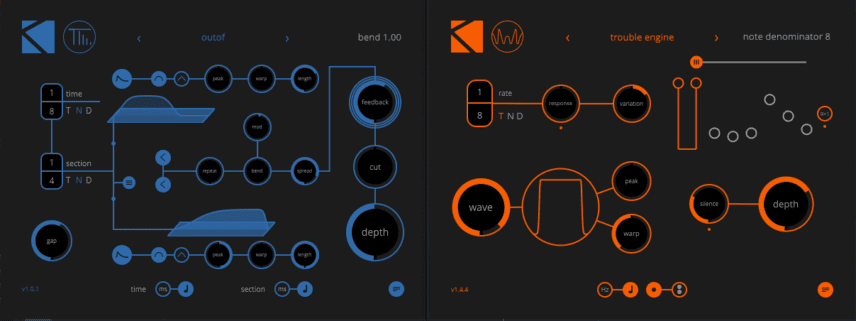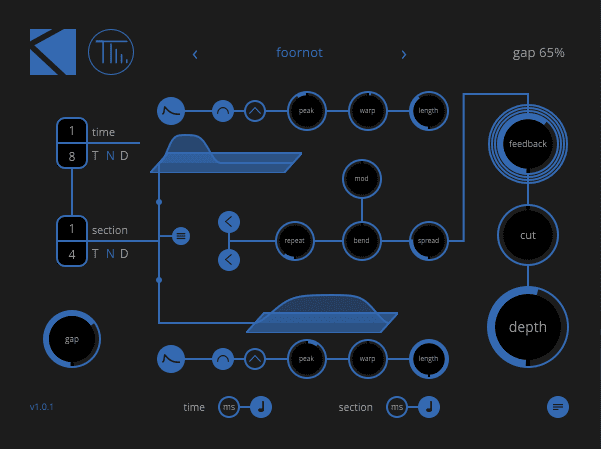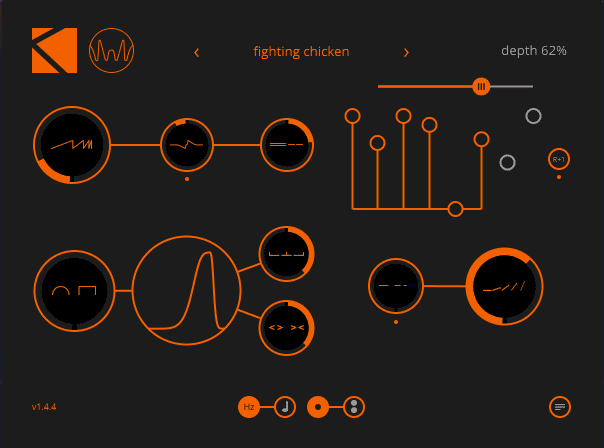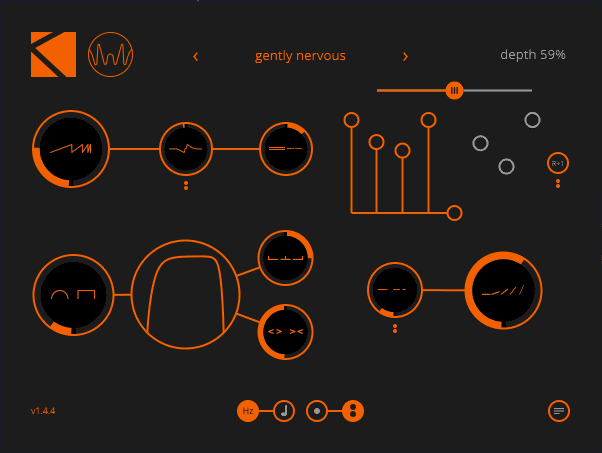A tremolo and a tape delay could provide new inspiration for sound designers, but may be less accessible to the faint of audio heart, says James Russell
Just like the plugin version of a set of non-identical twins, TTAP and WOV were released into the world together under the name ‘Phoenix’ by K-Devices. With the developer’s previous experience in the world of Max For Live patches, these delay and reverb effects mark a new venture into VST, AU and AAX plugins.
In brief, WOV is an advanced tremolo plugin with highly adjustable volume curves and an almost sequencer-style approach to timing amplitude modulation. TTAP may sound like a trade deal, but it’s actually a tape delay, with two buffers, control over the envelope response of each, and the ability to put either into reverse playback.
A striking feature of both plugins is the approaches in their interfaces. Whether the style is a hangover from K-Devices’ Max For Live days, or simply an encouragement to use your ears, both make a distinctive impression.
By default, all controls are represented as symbols – although the symbolic representation of what each control does is generally unintuitive. To deal with this, there’s a readout at the top-right of the synth to tell you what you’re tweaking (knobs only, not buttons), or you can replace said symbols with words directly on each control. This starts new users out on an immediately confusing road, and this either/or choice of legending doesn’t help matters.
TTAP
Delay can be an essential part of sound design, so a delay plugin stocked with interesting, creative touches can be an inspiring tool. TTAP has these in spades, with two buffers on hand to set to different timebases, blend between, and feed back into each other.
Each buffer has a controllable envelope shape, helping to define plucky tight repeats to slow, ramping delays and anywhere in between. Far from standard ADSRs, the envelopes are shaped using Peak, Warp and Length parameters, for more hands-on, abstract shaping.
When you think of analogue-style tape delay, slow, reactive slewing of the delay time comes to mind, and TTAP satisfies the desire to grab and pull the delay time control up and down as it’s doing its thing. There’s no modulation of the delay time, though – although the Bend control does act in a similarly satisfying way and can itself be modulated.
One excellent feature of TTAP is the ability to reverse the playback of its buffers, providing yet more inspirational delay tones. This, combined with the ability to tweak envelopes for the delay taps, makes the two something of a killer feature for this one. Similarly interesting is the difference in sound when using either the Repeats function or the traditional Feedback control.
TTAP is delay-based food for thought. The number of genuinely new and inspiring sounds it can create will have you coming back to it again and again – that is, if you can work out the interface in the first place. One shame is the lack of presets (there are only 30 in TTAP and 30 in WOV) to showcase the plugins’ full potential and provide some starting points to sculpt their sound further.
WOW
Taking on the task of amplitude modulation is WOV, whose lower-left waveform represents the response of the trem, but can’t be tweaked itself – the parameters around its edges are there for that.
Changing the tremolo response feels intuitive, and immediately analogous to what’s happening. You can hear the changes you’re making to the waveform as well as just seeing them, with the steepness and sharpness of the waveform’s leading and trailing edges being satisfyingly audible over sustained sounds.
But WOV’s special power lies in its sequencer – far from putting out constant cyclic amplitude modulation, the plugin lets you specify up to eight steps, setting a level for each step. There are options to delay the right-hand side by one step when in stereo mode, and of course steps can be set to zero to provide gaps in the sequence.
One of the themes behind WOV is chance: the Silence parameter, for example, is more like a ‘chance of silence’ parameter, introducing the possibility that steps are missed entirely – use it in stereo mode to cover some unexplored territory. Variation, meanwhile, can throw in slower or faster cycles of the sequence, all down to your preference.
Elsewhere, the Response parameter affects the rate of your tremolo based on the signal’s input properties. In practice, the Response can have a large or small effect, but it really depends on what you’re putting into WOV.
Phoenix Bundle
Both WOV and TTAP will appeal to experimental sound designers who know their way around an audio signal. These plugins have a habit of pleasantly surprising you, and are genuinely different from what else is out there – enough to be able to inspire a track or two in a single session.
The architecture is such that the lack of LFOs doesn’t feel like a big problem, although playing about using DAW-based modulators does provide even more dimension to the experience. LFOs could have been included for users of DAWs without their own modulators, but it’s not a huge loss to the creative process – these are rhythmic processors to begin with.
A decent level of audio knowledge is necessary if you want to use WOV and TTAP with any level of command or intention, but the two can also serve those who are into happy-accident sound design – although less so due to the low preset count in each.
While it’s noble to push past the limitations of hardware-style interface design, WOV and TTAP reach too far into the abstract, making it hard to know what you’re actually doing. Sure, this can be an inspirational way to use a plugin – blindly grasping at parameters while using your ears to find out what’s truly right for each sound – but the approach seen in these plugins’ interfaces is too far from recogniseable to be comfortable, ending up more confusing than it is inspirational.
As a pair, WOV and TTAP cost €99, with each selling for €59 individually on the K-Devices website. However, we have arranged for Attack readers a special discount using the code kattack19. This discount code will give you 25% off a single product or 35% off both products (€75 instead of €99). Once added to the cart, apply the discount and the price will be reduced.
You can check out WOV here and TTAP here. Both work as VST, AU and AAX plugins for Mac and PC.
Offer valid until May 5th.
The Verdict
Price: Until May 5th €75 as a bundle.
Purchase: WOV and TTAP by K-Devices




